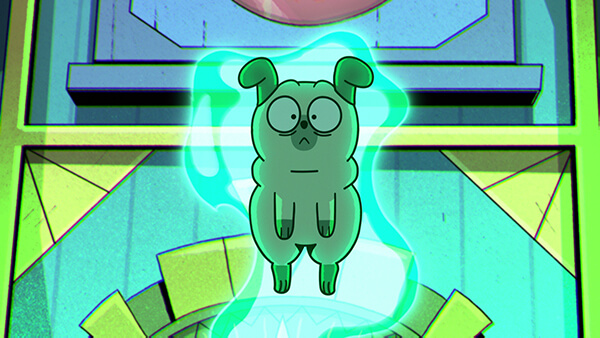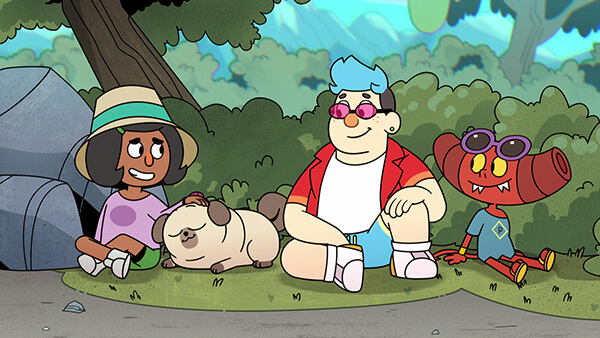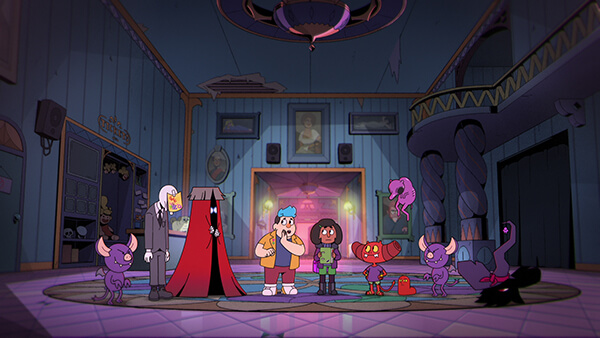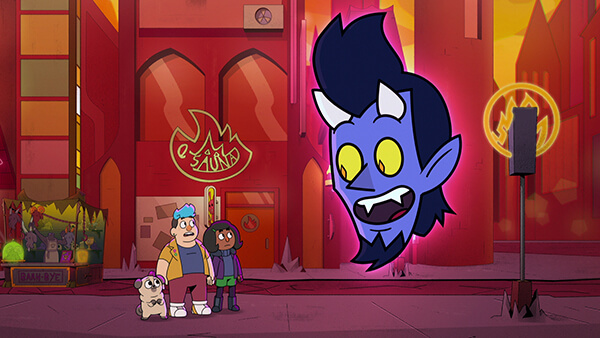Interview with Hamish Steele (‘Dead End: Paranormal Park’)
Released today on Netflix, Dead End: Paranormal Park is a ten-part horror comedy series for younger audiences created by animator, writer and comic artist Hamish Steele. Based on his graphic novel series DeadEndia that began in 2018 (which in turn loosely draws on characters and concepts from his 2014 Cartoon Hangover short film Dead End), the new series has been produced by Blink’s longform division Blink Industries, marking the studio’s first foray into the world of animated series development and production, following a number of shorter-form projects including the web series Don’t Hug Me I’m Scared and contributions to Love Death + Robots, Headspace, Off The Air and Inside No. 9.
Dead End: Paranormal Park follows the adventures of Barney, Norma and magical-talking-dog Pugsley, as they balance their summer jobs at the local theme park haunted house while battling the totally real supernatural forces that dwell within it. Together with their guide to the underworld multiplane, a sardonic thousand-year-old demon named Courtney, they’ll face zombie mascots, demonic game show hosts, sleep-sucking witches and the scariest thing of all: their first crushes!
Initially setting up a full crew-sized studio at North London’s Billiard Factory to fully produce the show in-house, the COVID pandemic required that the entire animation crew migrate to remote working on the fly. In spite of these unprecedented challenges, the end result is a show that has already generated online enthusiasm, with real heart, a well-developed core group of characters and incredible attention to detail in its production design. In anticipation of today’s show launch Skwigly spoke with creator Hamish Steele about the development of Dead End: Paranormal Park‘s world and its inhabitants, the importance of diversity and representation in contemporary children’s media and the unique circumstances under which the show was made.
What initially drew you to the world of comics and animation?
I’ve always done animation and comics at the same time, I’ve never been exclusively one or the other. When I was a teenager I was trying to animate things on Newgrounds, old Flash animations, things like that, and comics were also an important part because, to me, that was the quickest route of getting a story from my brain to in front of people’s eyes. So, kind of through indecision of which path I wanted to follow – which remains to this day – I studied a joint illustration/animation course at Kingston. It might be different now, but at the time it was the only thing that offered both, although in its second year you had to choose if you wanted to focus exclusively on illustration or animation – I chose animation. I started making shorts, some of them featured Pugsley, who’s a character in Dead End. And then one day, I think, on Tumblr, Frederator studios put up a call for submissions for that Cartoon Hangover shorts program. So I just took some of the characters I was drawing and sent a sort of beat board of an idea for a five minute short. I sent it during Hurricane Sandy, so everyone at the office didn’t have power and they didn’t see it, so one of the tips I give people when I’m teaching about pitching is that that can happen, just send another email if you don’t hear anything! So eventually they saw it, they loved it, we made a short – which you can still watch on YouTube – called Dead End, which I think sometimes gets reported as the pilot, but it has basically no connection to the new show. Through that short, I ended up making a few more for Nickelodeon. The last one, they put me in touch with Blink to help make it and that’s where I’ve basically been ever since, just pitching and developing shows for about ten years, and working on ads and music videos, while also working on my comics. Eventually I had a general meeting with Netflix about various things I was developing and they asked me if anything came of my old Dead End short, and that’s when I could show them that I’d turned it into a graphic novel. I never really officially pitched Dead End to them, I was pitching a bunch of things and then they were interested in my books. So there was a lot of aligning of planets, to get this made.
Those Nickelodeon shorts you did in the interim, were they part of a similar incubator scheme?
Yeah – you know, the industry has changed so much since then but I’m pretty sure there are still shorts programs, and they were international shorts programs, taking submissions from anybody, regardless of animation experience. I know Cartoon Network still does things like that, sometimes they can be more about finding internal talent and giving them a shot. But yeah, it was great. I mean, I always battled a little bit with whether these were truly pilots for future shows, or just one-off shorts. And I have a tendency to get a bit overexcited, so my first Nickelodeon short was a minute and a half, and I wrote like a 20 page bible about all the characters! It was honestly so great for me to learn and to direct things, right out the gate, but I think a very, very small percentage ended up becoming shows. I sometimes see comments saying “Oh, Cartoon Hangover finally turned Dead End into a show, but they weren’t involved at all, there’s no real throughline there, it just happens to be the thing I made a graphic novel out of.
So was the graphic novel series tied to the original short, or is it more it’s own thing that serves as the basis for the new series?
The new series is an adaptation of the books, I think there’s maybe a little blink-and-you’ll-miss-it reference to the short. And I love the short, but it was 2014 and I wrote it in 2012, so I’ve changed a lot as a storyteller, the characters in the world have changed a lot. It’s more of an interesting historical document to me now, of where the ideas came from.

Dead End: Paranormal Park (COURTESY OF NETFLIX ©2022)
There’s definitely a very visible style development.
A lot of what the original short was came about through a little bit of needing something to submit in a week or two. So I just threw the characters I was drawing in a haunted house, because I just thought it would make an interesting five-minute plot. But when I turned that into a graphic novel, which has a much longer-running storyline and character development, I had to justify a lot of the elements, like why are they living in a haunted house? Why is there a talking dog? Why are there supernatural things? What are the reasons for these things? So the short is just a five-minute comedy thing and the show is much more of a comedy/horror/drama/mystery hybrid. So it definitely delves into everything a little bit deeper.
So when it comes to adapting from your own source material, essentially, is there anything that needs to be actively changed or reworked to translate to a show, or were you able to keep it generally faithful to the original?
Well, I’ve said this a few times, but if someone else had taken the rights to the book and was adapting it, I would have probably told them to stick as close to the source material as possible. Because it was me, and because I’d already seen Dead End change over the years, I treated it as an opportunity to collaborate with other writers and make something new. So it is a faithful adaptation in tone, and themes, and it has a lot of the same story beats, but I think it’s a slightly different…it’s a scenic route, shall we say, through the story. One tiny difference is that in comics, the characters are in their 20s, because I was in my 20s and I wanted to write about my experiences, but then we pitched it as more of a kid’s show so we aged the characters down a little bit. It doesn’t affect things that much, but there are things you kind of bump up against in the story, like “Oh, they can’t go to that bar in the show”. So definitely comics and animation have slightly different standards of practice, I suppose. And as a horror comic and a horror story, navigating how horrifying you can go is definitely a fun challenge. I really enjoy creativity when it comes to horror. With kids’ horror you have to go down quite a surreal route, and that can actually end up being more weird and scary to me. I definitely think that, because I wrote the book on my own, the thing I was most excited about was working with other writers and artists and making something together. I never wanted to be an egomaniac saying “Stick to every single line!” because it’d be very silly of me to think that the best way to tell the story was the one I came up with when I was 21, writing completely on my own with no experience.

Dead End: Paranormal Park (COURTESY OF NETFLIX ©2022)
I think that’s a pretty healthy impulse, to look back at what you’ve done and think “Okay, this could be a foundation, maybe, but not necessarily the final product”. It’s nice that this project has had an organic lifespan to it.
Yeah, the things that are important to me were different 10 years ago, and will be different in 10 years time. So if the show hadn’t been greenlit until 20 years in the future, it would be a very different show, probably with very different priorities and perspectives. Dead End is me grabbing a bunch of characters from old things and putting them together. Sometimes they find themselves in situations where they’re a bit indecisive about which project, in their head, they want to go with. And I always think that, whichever one gets greenlit, everything that’s important to you about the other one will probably find its way into that version. I think lot of people treat any opportunity to get a show as their last possible opportunity to get a show and you should put everything that’s important to you in there.
So it’s been produced by Blink, which has a few different incarnations it would be good to unpack – it’s Blink Industries that’s producing this?
Yes, Blink Industries is the sort of programming arm, Blink Ink are more commercials. At the time, I think this was their first greenlit show, but some things made it to air quicker. One thing that’s interesting is that this is kind of unique among the Blink slate, because they specialise in a lot of mixed media things, puppetry and stuff like that. This is very much a 2D animated show, but one of the things that I think Blink did influence me on is the way the show is composited and the way it looks quite filmic, I suppose. A lot of interesting artificial lenses used to make the TV show look a little bit more special came a lot from my experience working on Blink things and the fact that there was no rule on how things should be done, I feel, at Blink.
Beyond being the creator, I’m assuming you’re quite hands on in the actual production itself. Are there any sort of particular areas that you’re most involved in, like writing or animation?
I was very involved in the writing, that was the thing I mostly wanted to do, and mostly want to do, post the show. I think I would love to freelance write more and be in other people’s writers’ rooms. My intention was to be way more hands-on with animation, and those two months we actually got to be in the studio together I was going up to everyone and acting scenes out and everything. With COVID it was so much harder and I had to accept delegating a lot more responsibility and trust to our animation directors, which ended up being fine, they’re all great, but my hope is, if I ever get to get another show, that I get to explore the animation side of things a little bit more, which I didn’t this time. But we at least got to be together for the initial art direction and deciding on the look and feel of the show together was vital. I think doing that over Zoom would have been pretty impossible, although other shows are doing it, so it can be done. But yeah, writing – it took a while to find the right tone for the show, because there’s nothing quite like ours in terms of balance. Some people’s first drafts were extremely zany comedy and some were very serious drama. Trying to find that right balance was a lot of what my job was, at the start.
Were there any other things that other members of the crew were able to bring to the show, that weren’t necessarily planned but helped with fleshing out the world, or adding little embellishments here and there?
Yeah, I can’t praise our art director Dommi Fox enough, because the theme park setting in the books is truly a backdrop, it’s a way to justify why the characters live in a haunted house. The thing that wowed me the most about Dommi’s art direction is that we didn’t design a setting for a TV show, we designed a functioning theme park with coherent branding! I can’t wait for the show to come out. There’s a full park map and it shows every single rubbish bin and lamppost and bench and ride entrance and where you can get the photos from that ride – and every gift shop, it’s so detailed! That means that in every single shot in the show we know exactly what rides you can see peeking over the horizon. Every single shot, we really made sure that the park felt like a real place. The one criticism I can make with the art direction is that in the books, it’s meant to be quite a run-down, depressing theme park. They didn’t necessarily take that note, or at least they were going to eventually, but Dommi’s first take on the park looks like everyone’s dream theme park, I’d love to go there, it’s so cool. So we went more in that direction, we made sure it actually looked like a fun place to be, which is a little bit different than comics. For a YA comic you can lean into the kind of depressing-ness; for a kids’ show, a note you always get is that the audience will want to be these characters and want to be part of this world, so make it appealing. So I was very impressed with how much collaboration helped make the world believable, I suppose, as a real park.

Dead End: Paranormal Park (COURTESY OF NETFLIX ©2022)
You mentioned about doing another show in the future. Is the story of this series kind of self-contained, or is there a hope to do more seasons after this?
Well, I’m working on the third book in the trilogy. And I think the show is intended to be three seasons, but I don’t know, with everything going on who knows if that will happen? It has to be a big success to justify that (laughs). But season one is a contained beginning/middle/end story. I just think it definitely leads the audience to believe there’s more stories in this world. I think about future projects, just because when Dead End was greenlit, I was in development on five or six things, and this is the thing that ‘won’, I suppose. So when I think about my future, I have to think of it in a kind of split multiverse – either we get to make as many seasons of Dead End as we want or I have to work out how I’m paying my bills.
It strikes me as the kind of show that could really get a strong fan base that would really dig in. It has those kinds of themes and those kinds of characterisations, the art style, everything that I could see people really kind of latching on to. Are there any particular hopes you have for what audiences will take from Dead End: Paranormal Park?
I believe that no matter what size our fan base is, they will be very loyal and the show will really mean a lot to them. I’ve already seen a little bit of it from the comic books but also, in the lead-up to the show, I can see people making friends and connecting through it and their connection to the characters. I mean, a lot of the press that I’ve been doing has been talking about the diversity and the characters who haven’t really been represented in kids’ media before, so definitely there’s a part of me that hopes people that relate to the characters do feel like there are people out there who have their back, and feel that they’re less alone. But I also hope that people who are very different to the characters can empathise with Barney and Norma – like, Barney is many things, but he is the audience surrogate in a way, he’s the eyes into this world, so I hope people can welcome him into their hearts (laughs). I also think, because I’ve talked so much about that aspect of the show, I think the fact that it’s a funny, horror comedy might sneak up on people and surprise them. That was really our main goal, was to make sure it was fun to watch, which sounds a bit obvious, but I think some things forget about that aspect, or it isn’t a priority. I feel like anyone who watches this show would probably have a good time.

Dead End: Paranormal Park (COURTESY OF NETFLIX ©2022)
Dead End: Paranormal Park is out now on Netflix

